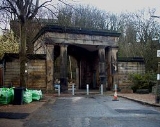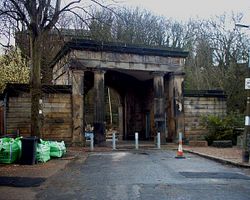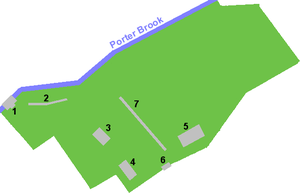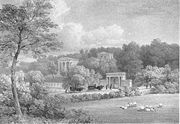
Sheffield General Cemetery
Encyclopedia

Cemetery
A cemetery is a place in which dead bodies and cremated remains are buried. The term "cemetery" implies that the land is specifically designated as a burying ground. Cemeteries in the Western world are where the final ceremonies of death are observed...
in the City of Sheffield
Sheffield
Sheffield is a city and metropolitan borough of South Yorkshire, England. Its name derives from the River Sheaf, which runs through the city. Historically a part of the West Riding of Yorkshire, and with some of its southern suburbs annexed from Derbyshire, the city has grown from its largely...
, England
England
England is a country that is part of the United Kingdom. It shares land borders with Scotland to the north and Wales to the west; the Irish Sea is to the north west, the Celtic Sea to the south west, with the North Sea to the east and the English Channel to the south separating it from continental...
that opened in 1836, and closed for burial in 1978. It was the principal cemetery in Victorian
Victorian era
The Victorian era of British history was the period of Queen Victoria's reign from 20 June 1837 until her death on 22 January 1901. It was a long period of peace, prosperity, refined sensibilities and national self-confidence...
Sheffield with over 87,000 burials. Today it is a conservation area
Conservation area
A conservation areas is a tract of land that has been awarded protected status in order to ensure that natural features, cultural heritage or biota are safeguarded...
(one of only six in South Yorkshire
South Yorkshire
South Yorkshire is a metropolitan county in the Yorkshire and the Humber region of England. It has a population of 1.29 million. It consists of four metropolitan boroughs: Barnsley, Doncaster, Rotherham, and City of Sheffield...
), and it is listed on the English Heritage
English Heritage
English Heritage . is an executive non-departmental public body of the British Government sponsored by the Department for Culture, Media and Sport...
National Register of Historic Parks and Gardens
National Register of Historic Parks and Gardens
In England, the Register of Historic Parks and Gardens of special historic interest in England provides a listing and classification system for historic parks and gardens similar to that used for listed buildings. The register is managed by English Heritage under the provisions of the National...
. It is owned by the City of Sheffield and managed on behalf of them by local community group Sheffield General Cemetery Trust.
Location
The cemetery is located to the south-west of central Sheffield. It is in the district called SharrowSharrow
For the village in North Yorkshire, see Sharow. For the shared lane roadway marking, see Shared lane marking.Sharrow is a district of Sheffield directly south west of Sheffield city centre....
, on a north-facing hillside between Sharrow Vale and Sharrow Head. The Porter Brook
Porter Brook
The Porter Brook is a river in the City of Sheffield, Englanddescending over 300 metres from its source among the sedge grass on Burbage moor behind a small farm on Hangram just inside the Peak District National Park in the west of the city at Clough Hollow, near the village of Ringinglow...
runs along its north-western edge, the south-eastern boundary is Cemetery Road.
History



United Kingdom of Great Britain and Ireland
The United Kingdom of Great Britain and Ireland was the formal name of the United Kingdom during the period when what is now the Republic of Ireland formed a part of it....
. Its opening in 1836 as a Nonconformist cemetery was a response to the rapid growth of Sheffield and the relatively poor state of the town's churchyards. The cemetery, with its Greek Doric and Egyptian style buildings, was designed by Sheffield architect Samuel Worth (1779–1870) on the site of a former quarry. Landscaping was managed by Robert Marnock
Robert Marnock
Robert Marnock was one of the outstanding horticulturalists and garden designers of the 19th century and was considered by his contemporaries to be the best exponent of the gardenesque school of landscape gardening....
, who also designed Sheffield Botanical Gardens
Sheffield Botanical Gardens
The Sheffield Botanical Gardens are botanical gardens situated off Ecclesall Road in Sheffield, England, with 5,000 species of plant in 19 acres of land....
(1836) and Weston Park (1873). The first burial was of Mary Ann Fish, a victim of tuberculosis
Tuberculosis
Tuberculosis, MTB, or TB is a common, and in many cases lethal, infectious disease caused by various strains of mycobacteria, usually Mycobacterium tuberculosis. Tuberculosis usually attacks the lungs but can also affect other parts of the body...
. An Anglican cemetery was consecrated alongside the Nonconformist cemetery in 1846—the wall that divided the un-consecrated and consecrated ground can still be seen today. By 1916 the cemetery was rapidly filling up and running out of space, burials in family plots continued through the 1950s and 1960s, but by 1978 ownership of the cemetery had passed to Sheffield City Council and it was closed to all new burials. In 1980 the council got permission by Act of Parliament
Act of Parliament
An Act of Parliament is a statute enacted as primary legislation by a national or sub-national parliament. In the Republic of Ireland the term Act of the Oireachtas is used, and in the United States the term Act of Congress is used.In Commonwealth countries, the term is used both in a narrow...
to clear 800 gravestones to make a recreation area. Through the 1980s and 1990s most of the rest of the cemetery was left untouched, becoming overgrown and an important sanctuary for local wildlife. Unfortunately, many of the buildings also fell into disrepair. In early 2003 work began to restore the gatehouse and catacombs funded by a £500,000 grant from the Heritage Lottery Fund
Heritage Lottery Fund
The Heritage Lottery Fund is a fund established in the United Kingdom under the National Lottery etc. Act 1993. The Fund opened for applications in 1994. It uses money raised through the National Lottery to transform and sustain the UK’s heritage...
.
Notable buildings and structures
- The Gatehouse (Grade II listed) is built directly over Porter BrookPorter BrookThe Porter Brook is a river in the City of Sheffield, Englanddescending over 300 metres from its source among the sedge grass on Burbage moor behind a small farm on Hangram just inside the Peak District National Park in the west of the city at Clough Hollow, near the village of Ringinglow...
in classical architecture with Egyptian features. The gateway resembles a Roman arch. It was possibly built over the river so that entering the cemetery was symbolic of the crossing of the river StyxStyx (mythology)The Styx is a river in Greek mythology that formed the boundary between Earth and the Underworld . It circles the Underworld nine times...
in Greek mythologyGreek mythologyGreek mythology is the body of myths and legends belonging to the ancient Greeks, concerning their gods and heroes, the nature of the world, and the origins and significance of their own cult and ritual practices. They were a part of religion in ancient Greece...
.
- The Egyptian Gate (Grade II listed) is the entrance to the cemetery on Cemetery Road. It is richly ornamented and possesses a sculpted gate bearing two coiled snakes holding their tails in their mouths.
- The Nonconformist chapel (Grade II listed) is built in classical style with Egyptian features. The sculpted panel above the door shows a dove, representing the Holy Ghost or the Holy Spirit. Stone steps lead down to a wall with catacomb-like entrances.
.jpg)
- The Anglican chapel (added in 1850; Grade II listed). Designed in the Neo-GothicGothic Revival architectureThe Gothic Revival is an architectural movement that began in the 1740s in England...
style by William FlocktonWilliam FlocktonFlockton's were a series of architectural firms in the 19th and early 20th centuries, based in Sheffield, England. The firms were responsible for a number of significant buildings, particularly in the Sheffield area.-William Flockton:...
. Unlike the other buildings in the cemetery, the chapel was built in Gothic style rather than Classical or Egyptian. The building is distinctive in style due to its ogivalOgiveAn ogive is the roundly tapered end of a two-dimensional or three-dimensional object.-Applied physical science and engineering:In ballistics or aerodynamics, an ogive is a pointed, curved surface mainly used to form the approximately streamlined nose of a bullet or other projectile.The traditional...
windows, the porte-cochere and the spire. The spire is indeed far too big for the rest of the building, built purposely so that it would be seen from afar.

- The Registrar's house (Grade II listed)
- The Catacombs. There are two rows of catacombsCatacombsCatacombs, human-made subterranean passageways for religious practice. Any chamber used as a burial place can be described as a catacomb, although the word is most commonly associated with the Roman empire...
built into the hillside, this method of burial was unpopular and only ten bodies were laid to rest in the catacombs in the first 10 years. - The Dissenters' Wall was built between 1848 and 1850. It divided the older Nonconformist part of the cemetery from the consecrated Anglican ground. The wall runs almost uninterrupted, from the perimeter wall on Cemetery Road to the path beside the Porter Brook at the bottom of the cemetery.
Notable burials
- George BassettGeorge BassettGeorge Bassett was the founder of a confectionery firm in Sheffield in 1842. The company introduced Liquorice allsorts. He went on to become Mayor of Sheffield . Whilst Mayor, he had US President Ulysses S. Grant as a house guest. He was born in Ashover, Derbyshire, and married Sarah Ann Hague:...
(1818–1886). Founder of The Bassett Company—the company that invented Liquorice AllsortsLiquorice allsortsLiquorice allsorts consist of a variety of liquorice sold as a mixture. These confections are made of liquorice, sugar, coconut, aniseed jelly, fruit flavourings, and gelatine. They were first produced in Sheffield, England, by Geo...
. Lord Mayor of Sheffield (1876). - George BennettGeorge Bennett (missionary)George Bennet was a missionary originally from Sheffield, Yorkshire. He traveled to China, Southeast Asia, and India for the London Missionary Society, along with Reverend Daniel Tyerman....
(died 1841). Founder of the Sheffield Sunday School movement. The memorial to him (c.1850) is Grade II listed. - John, Thomas, and Skelton Cole. Founders of Sheffield's Cole Brothers department store in 1847—now part of the John Lewis PartnershipJohn Lewis PartnershipThe John Lewis Partnership is an employee-owned UK partnership which operates John Lewis department stores, Waitrose supermarkets and a number of other services...
. - Francis Dickinson (1830–1898). One of the soldiers who fought in the Charge of the Light BrigadeCharge of the Light BrigadeThe Charge of the Light Brigade was a charge of British cavalry led by Lord Cardigan against Russian forces during the Battle of Balaclava on 25 October 1854 in the Crimean War. The charge was the result of a miscommunication in such a way that the brigade attempted a much more difficult objective...
during the Crimean warCrimean WarThe Crimean War was a conflict fought between the Russian Empire and an alliance of the French Empire, the British Empire, the Ottoman Empire, and the Kingdom of Sardinia. The war was part of a long-running contest between the major European powers for influence over territories of the declining...
. - William DronfieldWilliam DronfieldWilliam Dronfield was a British trade unionist.Born in Sheffield, Dronfield became a compositor. In 1849, he was a founder member of the Provincial Typographical Association, and from 1852 to 1855 served as its President....
(1824–1891). Founder of the United Kingdom Alliance of Organised Trades, which inspired the creation of the Trades Union CongressTrades Union CongressThe Trades Union Congress is a national trade union centre, a federation of trade unions in the United Kingdom, representing the majority of trade unions...
. - Mark FirthMark FirthMark Firth was an English industrialist and philanthropist.Born in Sheffield, Mark joined the crucible steel works of Sanderson Brothers where his father worked as head smelter, but left in 1842 to set up his own business with his brother, Thomas Jr, in 1842...
(25 April 1819–28 November 1880). Steel manufacturer, Master Cutler (1867), Lord Mayor of Sheffield (1874), and founder of Firth College in 1870 (later University of SheffieldUniversity of SheffieldThe University of Sheffield is a research university based in the city of Sheffield in South Yorkshire, England. It is one of the original 'red brick' universities and is a member of the Russell Group of leading research intensive universities...
). The monument to Mark Firth is Grade II listed, the railings that surround it were made at Firth's Norfolk Works. - William Flockton, architect.
- John Fowler. Father of the designer of the Forth Rail Bridge (also called JohnJohn Fowler (engineer)Sir John Fowler, 1st Baronet KCMG LLD was an English civil engineer specialising in the construction of railways and railway infrastructure. In the 1850s and 1860s, he was engineer for the world's first underground railway, London's Metropolitan Railway, built by the "cut-and-cover" method under...
). - John Gunson (1809–1886). Chief engineer of the Sheffield Water Company at the time of the collapse of Dale Dyke Dam on 11 March 1864, which resulted in the Great Sheffield FloodGreat Sheffield FloodNot to be confused with the floods in Sheffield in 2007.The Great Sheffield Flood was a flood that devastated parts of Sheffield, England, on 11 March 1864, when the Dale Dyke Dam broke.- Collapse of Dale Dyke Dam :...
. Samuel Harrison, who documented the flood, and 77 of the flood's victims are also buried in the cemetery. - Samuel HolberrySamuel HolberrySamuel Holberry was a prominent Chartist activist.-Early years:Holberry was born in Gamston, Nottinghamshire, the youngest of nine children...
(1816–1842). A leading figure in the Chartist movement. - Isaac IronsideIsaac IronsideIsaac Ironside was a British Chartist and socialist politician.-Early years:Born near Masbrough, Rotherham, Ironside grew up in Sheffield, the son of Samuel Ironside, a Wesleyan lay preacher, and Mary Bradbury...
(1808–1870). Chartist and local politician. - James MontgomeryJames MontgomeryJames Montgomery was a British editor, hymnwriter and poet. He was particularly associated with humanitarian causes such as the campaigns to abolish slavery and to end the exploitation of child chimney sweeps....
(1771–1854). Poet/Publisher. The grave and Grade II listed monument to James Montgomery, were moved to the grounds of Sheffield CathedralSheffield CathedralSheffield Cathedral is the cathedral church for the Church of England diocese of Sheffield, England. Originally a parish church, it was elevated to cathedral status when the diocese was created in 1914...
in 1971. - James Nicholson (died 1909). Prominent Sheffield industrialist. The memorial that he commissioned for himself and his family c.1872 is Grade II listed.
- William Parker, merchant. The monument to William Parker, erected in 1837 by the merchants and manufacturers of Sheffield, is Grade II listed.Monument to William Parker 40m south-west of Old Chapel at General Cemetery. Images of EnglandImages of EnglandrightImages of England is an online photographic record of all the listed buildings in England at the date of February 2001. The archive gives access to over 323,000 colour images, each of which is matched with the item’s listed designation architectural description.This ‘snapshot’ is not an...
(accessed 11 February 2006).

